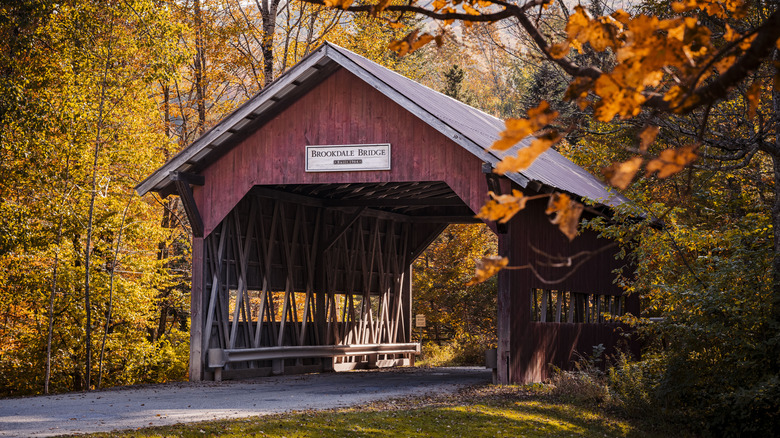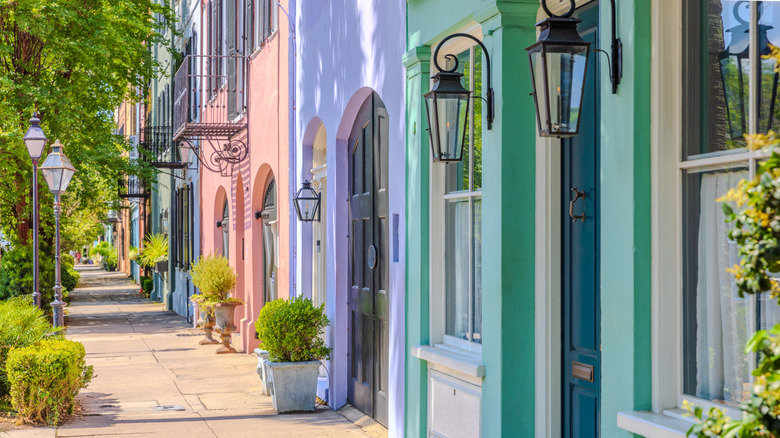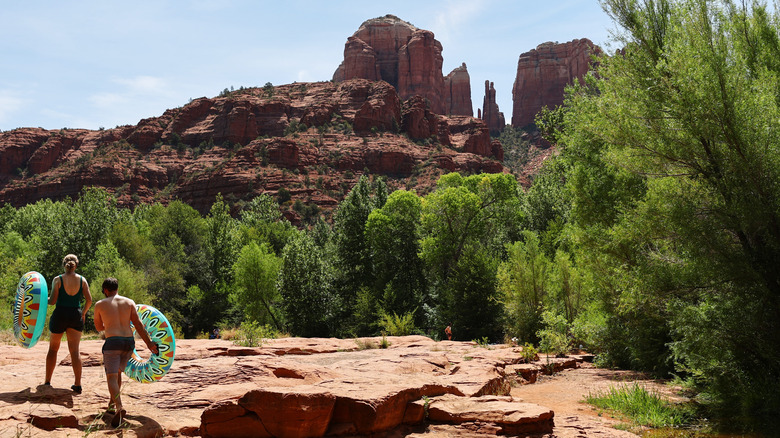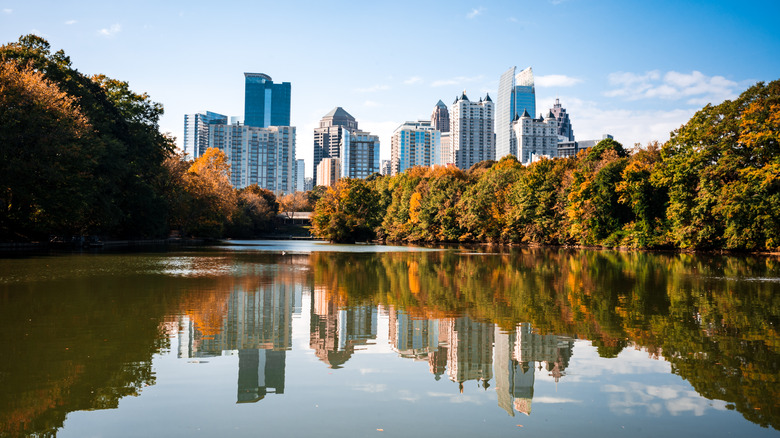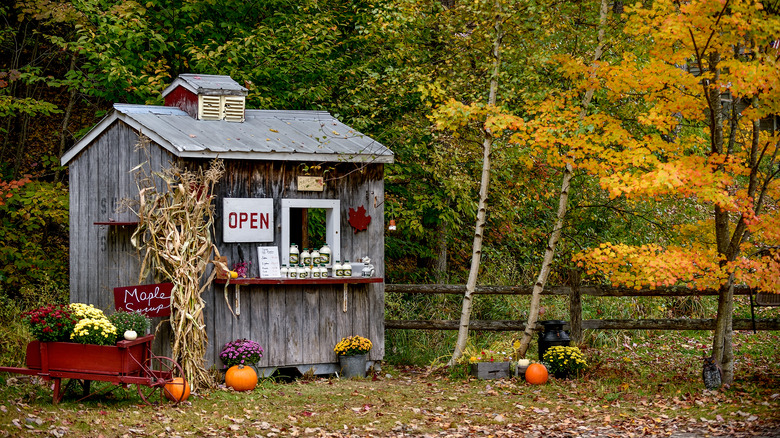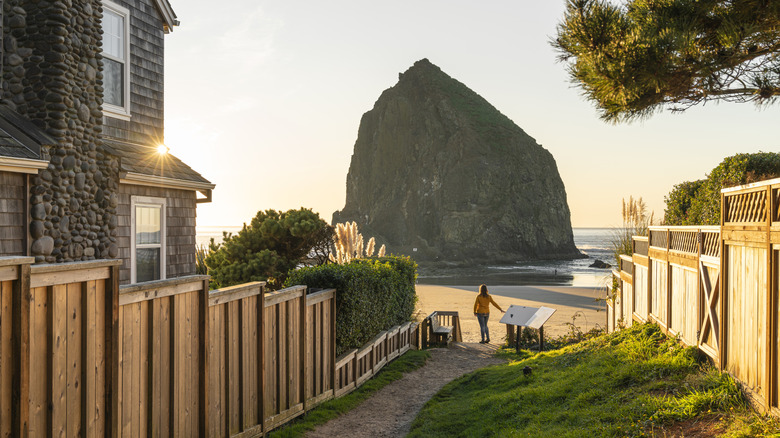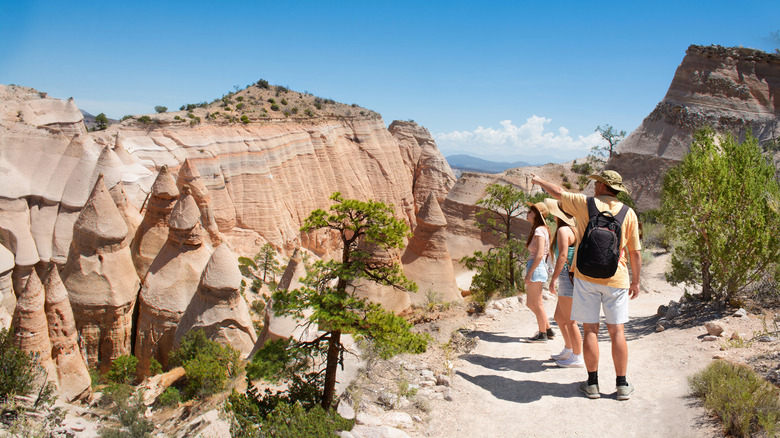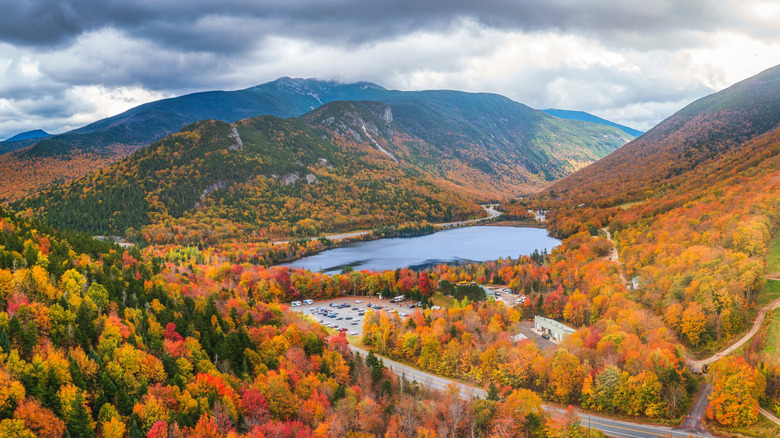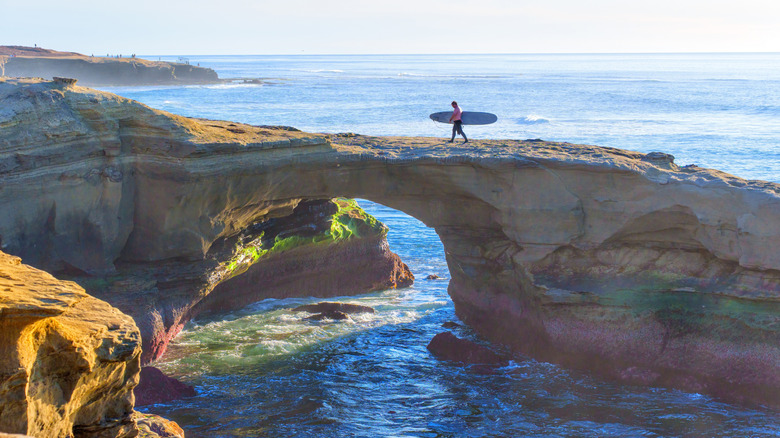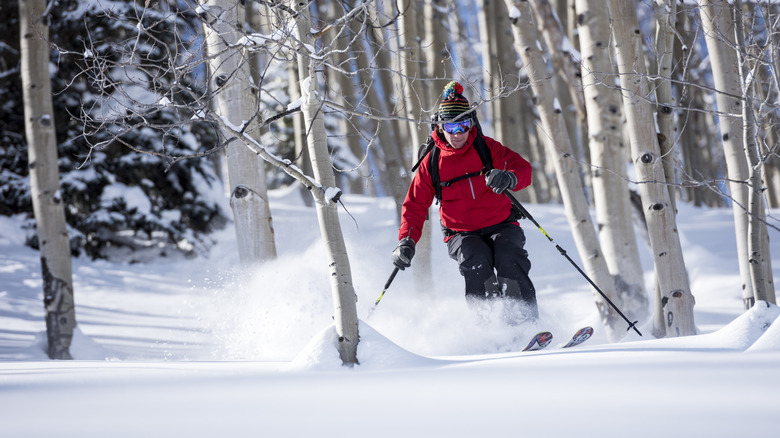These U.S. States Are Beloved For Having Gorgeous Weather All Year Long
Have you ever visited a state and yearned to experience it again in another season? Plenty of states have gorgeous weather year-round, warranting repeat trips and even relocations. When I write "gorgeous weather year-round," I am not necessarily referring to states where you can lounge under the sun in a swimsuit, even in December. While places like that exist — and have earned their spots on this list — I have also included states like Vermont and Utah, which many folks find particularly beautiful during the winter. Whether hunting for sunny weather or snow-capped peaks, you will find a state on this list that suits your needs and interests. For each one, I will provide a handful of recommendations for outdoor activities that can be enjoyed throughout the year.
I curated this guide based on the typical climate of each state, relying on factors such as rainfall frequency, humidity levels, and year-round average temperatures. I also based my recommendations for activities on personal experience, considering I have visited all 50 states (the majority, more than once). It is important to note that the weather varies from year to year. Taking into account relatively predictable meteorological phenomena, like the El Niño and La Niña climate patterns, can help you plan your trip well. More notes on my methodology can be found at the end of this article.
South Carolina
Except for the mountainous region in the northwestern part of the state, South Carolina experiences mild winters. This makes sense given that it is located in the southern United States and has a relatively low-lying profile. Sassafras Mountain, with an elevation of 3,553 feet, is the state's highest point. While it can get hot in the summer, especially along the coast, many see it as the perfect excuse to pitch an umbrella on the beach, sip on lemonade, and relax.
Indeed, South Carolina's beach towns are something special. If you have kids, I highly recommend visiting Hilton Head Island, which offers a myriad of resorts for family vacations. Here, you can spot dolphins, cycle on 200-plus miles of bike paths, and lounge on 12 miles of white sand beaches. Additionally, Hilton Head is known as "The Golf Island," so if you are itching to get your hands on a set of golf clubs, you can count on world-class greens to exhibit your skills.
For adults, Charleston is a must-visit destination in South Carolina. It brims with cultural experiences and superb restaurants that will please all types of foodies. Make sure to check out sites like Fort Sumter and The Battery for a lesson on Civil War history. A walk in the French Quarter, including Rainbow Row, is also not to be missed. Other popular towns and cities — like Myrtle Beach, Pawley's Island, Sullivan's Island, and Greenville — offer countless outdoor activities that can be pursued year-round.
Arizona
Arizona is the sixth-largest state in America, so you can expect varied ecosystems and weather patterns during your visit. Whether you can bundle up in a jacket and mittens or walk around in a T-shirt largely depends on the region and altitude in which you find yourself. Greater Phoenix has aptly earned the nickname "The Valley of the Sun," and as you might expect, it experiences mild winters. In contrast, Flagstaff, which lies only nearly three hours away by car, is much colder during the winter months. This is in part due to its higher elevation (7,000 feet compared to Phoenix's 1,100 feet).
Located between Phoenix and Flagstaff is the Verde Valley, which is famous for picturesque landscapes and a plethora of outdoor activities, no matter the season. While the Verde Valley occasionally receives snowfall, I can confirm that gazing at the red rocks when they are laced with snow is nothing short of stunning. Besides, most winter days are sunny here, allowing you to go horseback riding, hiking, golfing, or biking at your leisure. While winters can be brisk, summers can be hot. Thankfully, you can cool off in one of the region's rivers and swimming holes. You might also like to venture out at night; Sedona is lauded as one of the nation's top stargazing destinations.
The Grand Canyon and Monument Valley are a few of the other places that offer gorgeous views year-round. You might prefer to visit them in the winter, when tourists are not so numerous. However, you should be prepared for each destination's unique conditions. For example, while snow rarely causes traffic issues in Monument Valley, roads around the Grand Canyon can be quite slippery.
Utah
Utah is a paradise for nature enthusiasts, offering popular activities like hiking, mountain biking, kayaking, and skiing, as well as slightly more obscure sports like paragliding and ice climbing. You could easily spend weeks in Utah exploring its various regions. Utah is often divided into the Colorado Plateau in the south, the Rocky Mountains in the northeast, and the Basin and Ridge region in the west. Even within these three regions, however, there are several distinct zones with their own cultures, climates, and geographies.
I suggest embarking on a Mighty 5 Road Trip to see Southern Utah; it can be done any time of the year, with each season having pros and cons. The right month to visit depends on what activities you wish to pursue and how patient you are in dealing with crowds. No matter what, though, the rock spires in places like Canyonlands National Park and Bryce Canyon National Park will never fail to impress you. Meanwhile, Utah's mountains are beloved for their ski resorts. They are home to big names like Park City, Alta, Snowbasin, Sundance, Powder Mountain, Brighton, and Snowbird. Some resorts, like Snowbasin and Deer Valley, allow hiking and biking during warmer months when all the snow has melted.
Finally, Utah's Great Basin region promises to nurture the curiosity of all those interested in ghost towns, geology, and fossils. During the spring and fall, you can't pass up an opportunity to play in the sand at Little Sahara Recreation Area. Fall is likewise a wonderful time to take a dip in geothermally heated springs, like Gandy Warm Springs.
Georgia
Georgia is perhaps best known for the city of Atlanta, which provided a backdrop for "Black Panther" and saw major demonstrations during the Civil Rights Movement. You can still see the birth home of Martin Luther King, Jr., perhaps as part of a larger civil rights tour. Beyond historical excursions, you can partake in an abundance of other outdoor activities in Atlanta. I love dancing at music festivals that take advantage of the mild spring and fall weather conditions, such as the SweetWater 420 Fest and Shaky Knees.
Meanwhile, the Atlanta Botanical Garden is vibrant with life year-round. The smiling monkey tree, for instance, blooms in late winter or early spring, at which time it entices visitors with its scent and beauty. If you get caught in the rain, you can always retreat indoors to attractions like the APEX Museum and the World of Coca-Cola.
Another destination that you can visit during all four seasons is North Beach on Tybee Island. Whether you ascend the tallest, oldest lighthouse in Georgia or paddle a kayak and watch for birds, you are in for an active and memorable vacation. If you need a retreat from the heat of summer or want to get into the holiday spirit with a dose of cold weather, Georgia's mountains are an underrated region worth exploring. Springer Mountain is where the Appalachian Trail begins, so you will find plenty of folks here between March and April.
Hawai'i
It's no secret that for a tropical vacation involving surfing, boogie boarding, and plenty of sunbathing, you need to keep an eye out for cheap flights to Hawai'i. It's important to remember, though, that Hawai'i does have distinct seasons. Additionally, the state is made up of eight main islands and plenty of microclimates. Impressively, the island of Hawai'i is just two short of the 13 total climate zones that are often recognized on Earth. That means that you can spend the morning hiking through dense rainforest and the afternoon summiting a cold, arid, and volcanic peak. Indeed, I have done just that in Haleakala National Park. It is also worth noting that inclement weather often passes quickly across the state.
The best time of year to visit Hawai'i depends on your priorities. For instance, during the winter, Hawai'i acts like a magnet for surfers hoping to catch big waves at Oʻahu's North Shore. Because of its year-round warm weather, Hawai'i is also a great state for folks who would rather be sipping on a mai tai than hot cocoa during the holiday season. Not to mention, whale watching during the winter is superb. However, winter is often accompanied by high winds and rainstorms, so if reading a book peacefully by the sea is what you are looking for, you might have better luck in the summer. If you love to eat, this is also the time you can experience events like the Mango Festival on Hawai'i island and the Pineapple Festival on Lāna'i island.
Vermont
Vermont has got it all, from skiing the slopes of Stowe Mountain Resort in the winter to savoring maple creemees during the summer (which only averages about 80 degrees Fahrenheit). In between the hottest and coldest days of the year, Vermont promises stunning autumnal foliage and gorgeous springtime flowers. It's hard not to fall in love with the local culture, especially when you witness sugarhouses in full swing. They produce maple syrup or stay at a farmhouse and wake up to the sounds of chickens clucking and cows mooing. These may sound like cliché characterizations, but experiences like these are readily available in Vermont. I particularly recommend exploring the Green Mountains around Burlington, where I have spent ample time cycling, hiking, and indulging in food tours (hello, Ben & Jerry's!).
If you haven't traveled with gear, no worries. Vermont's tourism infrastructure is set up to support anyone who wants to rent a bike, a pair of skis, or a kayak, and there are plenty of local guides who can show you the lay of the land. Remember to bring along cash to tip your guide. Not only is it good for the local economy, but it might encourage your guide to introduce you to a hidden gem that tourists don't know about. Whether it's a swimming hole tucked away off a side trail or a vantage point to better appreciate the foliage while inhaling crisp fall air, you'll never run out of natural features to explore in Vermont, no matter the time of year.
Oregon
Oregon is often divided into seven regions. They are Central Oregon, Eastern Oregon, Southern Oregon, the Willamette Valley, the Portland Region, Mt. Hood and the Columbia River Gorge, and the Oregon Coast. As you might expect from such a large state, you might be licking a cone of ice cream in one corner of Oregon, while someone bundles up in a warm raincoat a few hundred miles away.
I once biked from Portland, Oregon, to Bellingham, Washington, and fell in love with the Pacific Northwest coast along the way. The juice stains from foraging for blackberries eventually washed away. However, my memories of splashing in the ocean and hiking through temperate rainforests will take much longer to fade. Because some tourist destinations receive high traffic in the summer, I recommend visiting a few of Oregon's underrated state parks to soak up the views in peace.
If the beach is calling your name, consider Cannon Beach or Seaside. Both are within driving distance of Portland, and the ocean breeze helps keep them cool, even during the dog days of summer (just be prepared for potential rain). You may have already seen images of Cannon Beach's Haystack Rock on a screensaver. You also can't miss spending a few nights in Portland, either; you'll need that time to decide which joint offers the best donuts (the city is famous for them). During the winter, head to Klamath Falls, which has been nicknamed the City of Sunshine, thanks to its estimated 300 days of sunny weather each year. This is a nice alternative to staying in Portland, which experiences mild winters but frequent rainfall.
New Mexico
New Mexico is commonly divided into four regions: The Colorado Plateau, the Rocky Mountains, the Great Plains, and the Basin and Range region. Each has its own appeal and weather patterns, depending on the altitude and region. While some parts of New Mexico are flat and well-suited to ranching, others feature jagged mountains that offer incredible bouldering and rock climbing adventures. Because New Mexico is such a large state by area — the fifth largest in the country, as a matter of fact — it is an excellent setting for your next road trip.
In New Mexico, there's an outdoor activity for everyone. Those who like to hike can tackle challenging trails in Bandelier National Monument while the rest of the family seeks out petroglyphs and learns about indigenous culture. Meanwhile, White Sands National Park is perfect for photographers hoping to capture images of an ethereal landscape. Carlsbad Caverns National Park will have you rethinking the earth beneath your feet. That's not to mention the tranquil vineyards that stretch across the state, where wines with various terroirs are produced, thanks to the distinct environments in which the grapes are grown. You can enjoy many of these activities year-round, though you should research conditions ahead of time.
New Hampshire
New Hampshire's awe-inspiring White Mountains attract hikers, bikers, and skiers year-round. One of its peaks, Mount Washington, is 6,288 feet high, reaching higher into the clouds than any other mountain in the northeast. Given the nature of this article, it is ironic that Mount Washington has earned the reputation of being the "Home of the World's Worst Weather." However, I would add the caveat that when the skies are clear, it is also the home of some of the world's best weather.
Indeed, from a higher elevation on a nice day, you can see five states and several magnificent peaks. You can summit Mount Washington on foot, a fun challenge during the summer months when conditions are generally warmer and safer. However, during the winter, it's a better idea to hop on board the Mount Washington Cog Railway, a groundbreaking feat of technology that has been operating since 1869.
You can also find spots in New Hampshire with milder weather. For the most part, coastal towns experience gentler winters than inland regions. This is especially true when high altitude and more northerly latitudes are at play. Regardless, there are a plethora of resorts in New Hampshire designed to maximize your comfort, no matter the season. Check out Attitash Mountain Village, where you might strap on a pair of cross-country skis in the winter or float down the river on an inner tube in the summer.
California
California is what usually comes to mind when folks yearn for sunny, balmy weather, minus the humidity. Specifically, though, this weather is to be found in Southern California, not Northern California. During my first visit to San Francisco, I was surprised to discover how cold the city can be, even during summer months. September and October are better bets for catching warm temperatures in the Bay Area. Foggy San Francisco's unique weather patterns are a result of a marine layer that draws cold air from the ocean, as well as its terrain and latitude.
On the other hand, the comfortable year-round weather in Southern California can largely be attributed to the Eastern Pacific High. This phenomenon creates a high-pressure zone in the area that is accompanied by warm weather and few rainclouds. Plus, the Eastern Pacific High joins forces with winds and the cool waters flowing south from the Aleutians to help mitigate extreme humidity. As a result, it is in a city like San Diego or Los Angeles that you can spike volleyballs on the beach all year round — with winter being even more comfortable for those who don't like to sweat very much.
Indeed, California is an excellent state for biking and even plays host to a slew of stunning e-bike trails along its coast. You'll find one of those trails on Coronado Island, a fantastic coastal getaway with numerous resorts and hotels that can accommodate you during a long weekend of golfing, sailing, shopping, and eating.
Methodology
I chose to expand the definition of "gorgeous weather" beyond that of persistently sunny and mild conditions. My definition relates more to weather conditions that are conducive to diverse outdoor activities. I favored states that offer myriad activities year-round rather than during just one or two peak seasons.
The specific criteria I included are the amount of yearly rainfall, the level of humidity, and the year-round average temperatures. Though climate change is certainly altering weather patterns across the country, I used historical data to curate this list. Finally, for large states with several different climate zones, I specified regions thought to be more enjoyable year-round.
